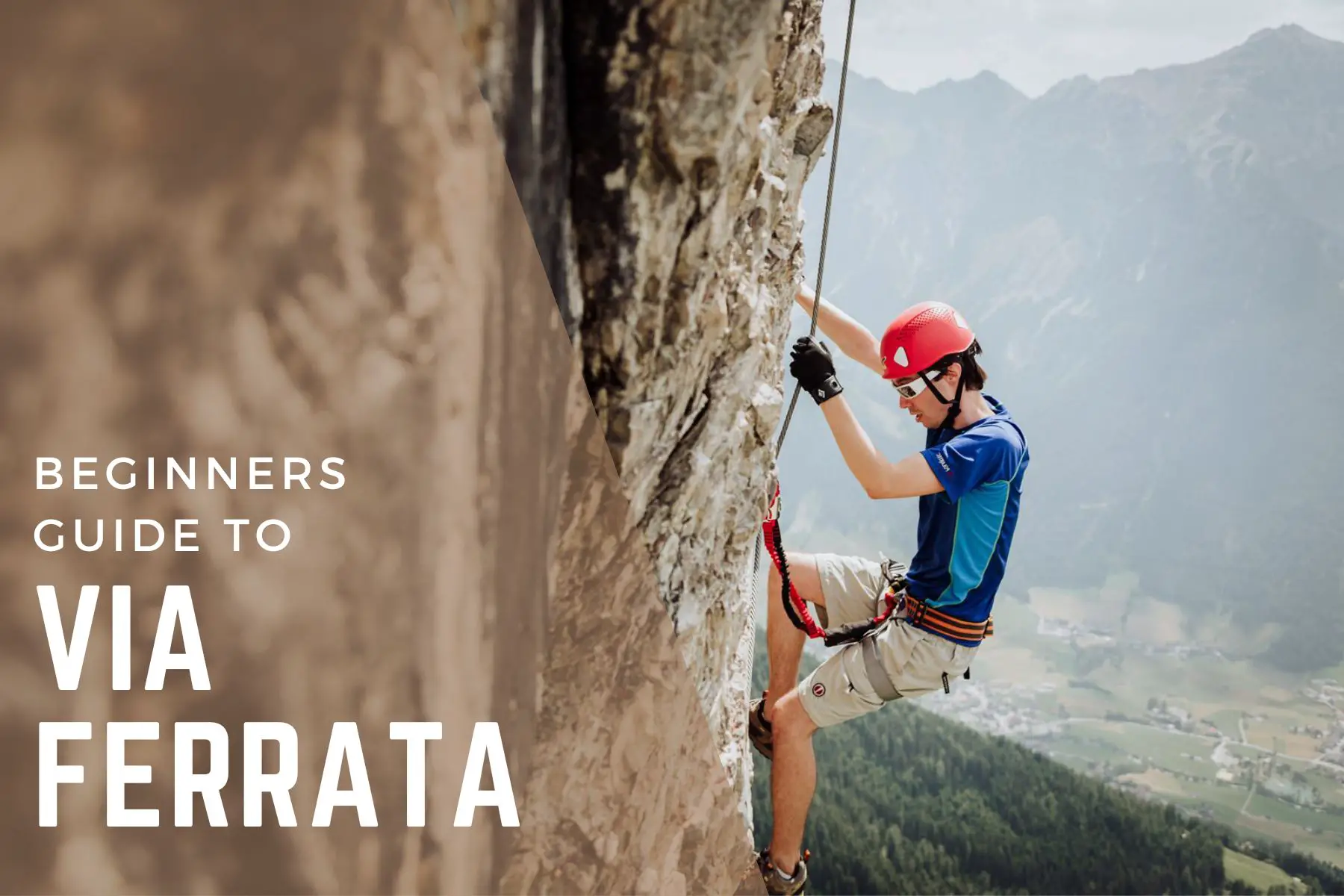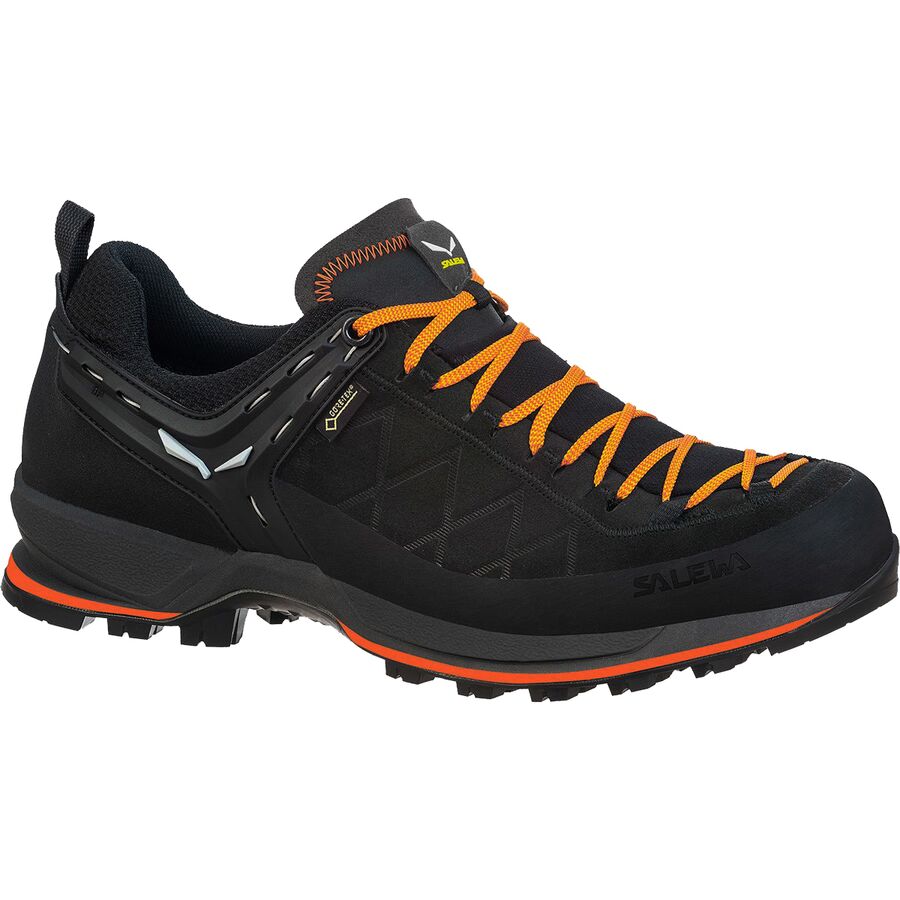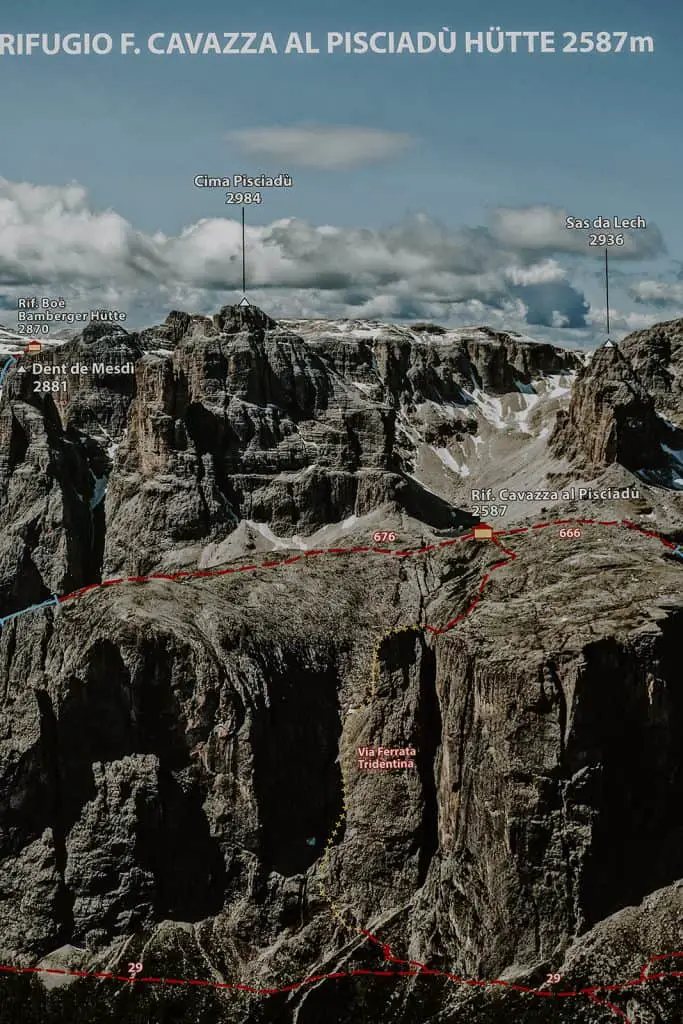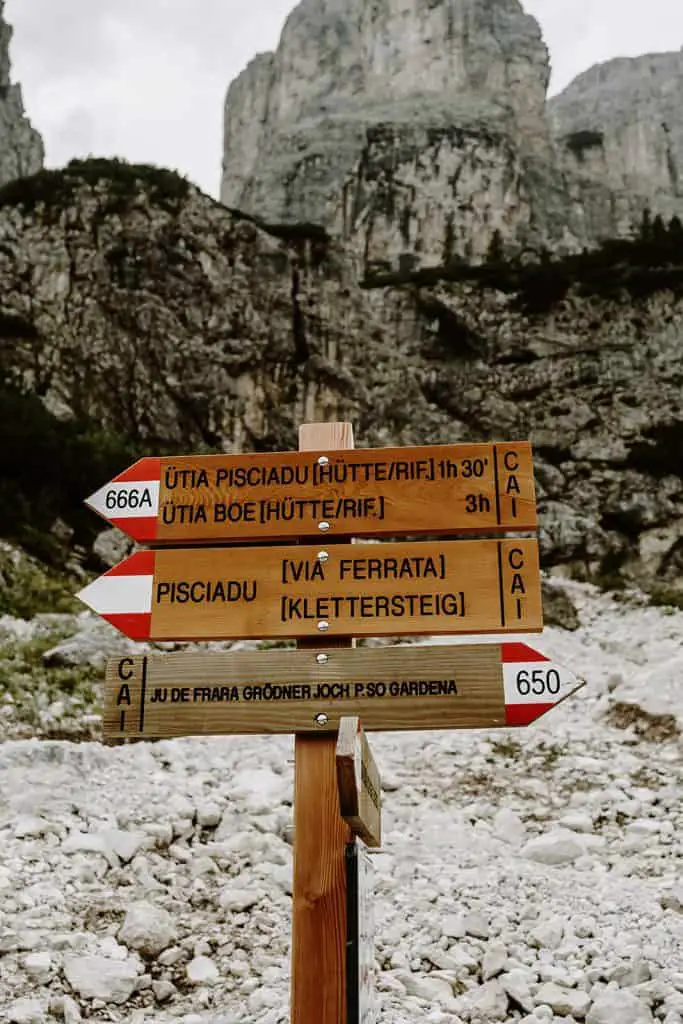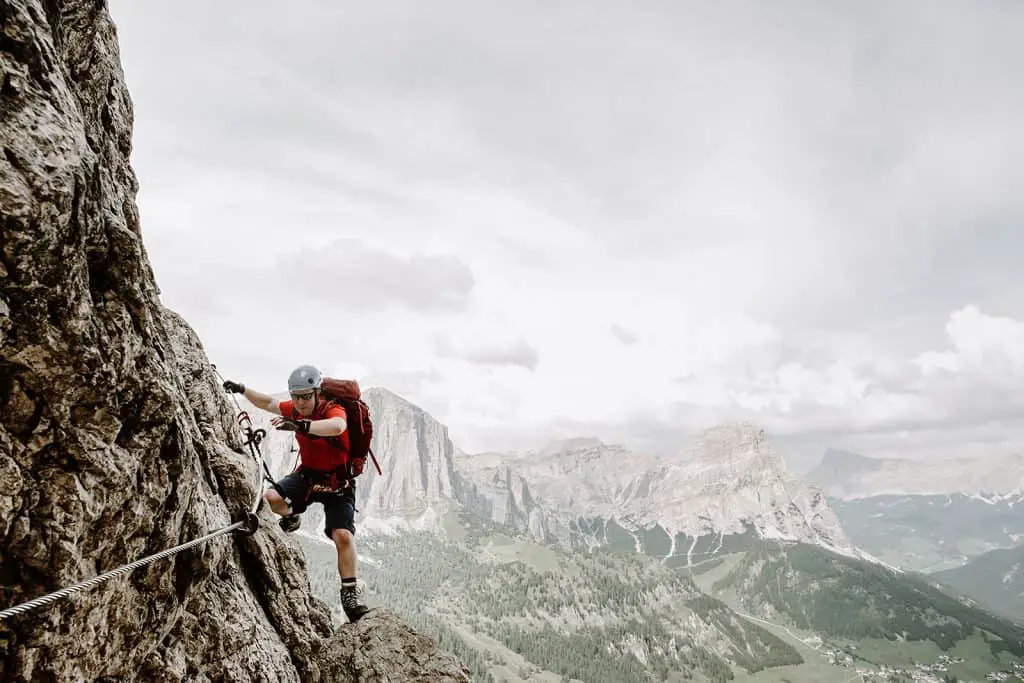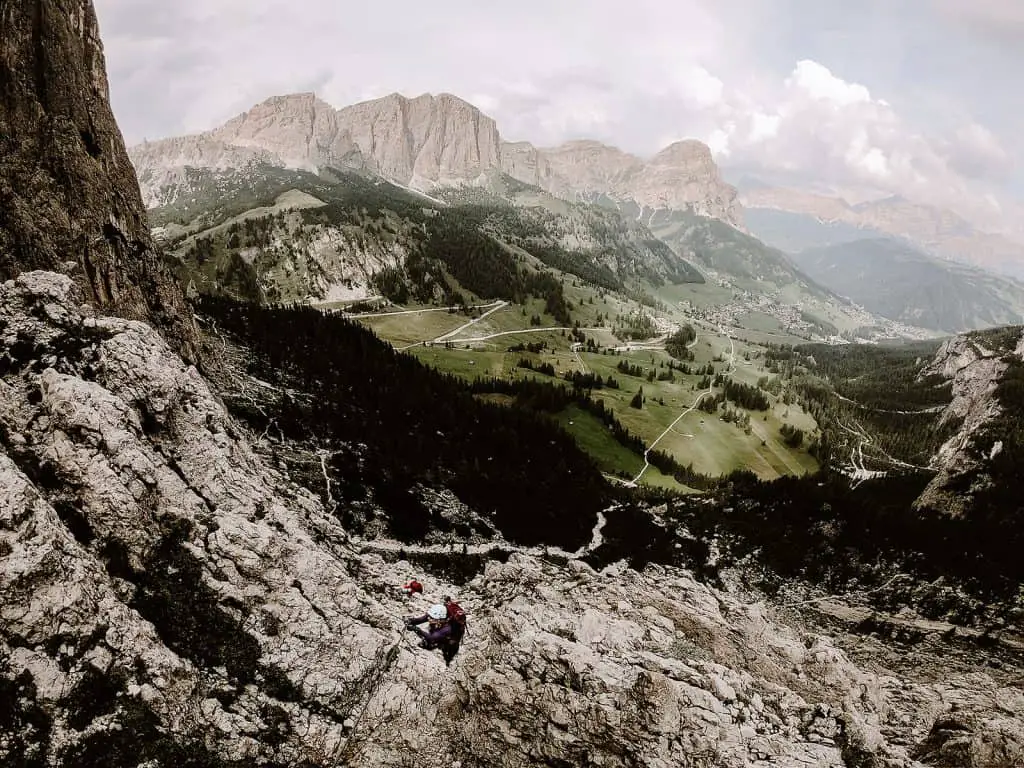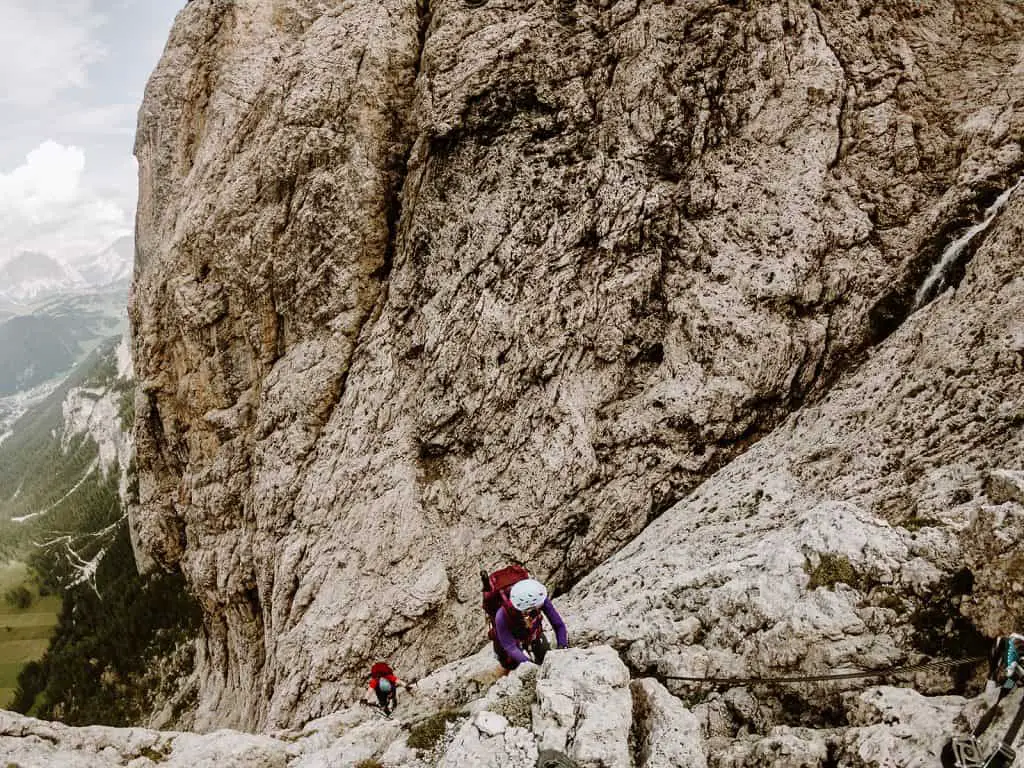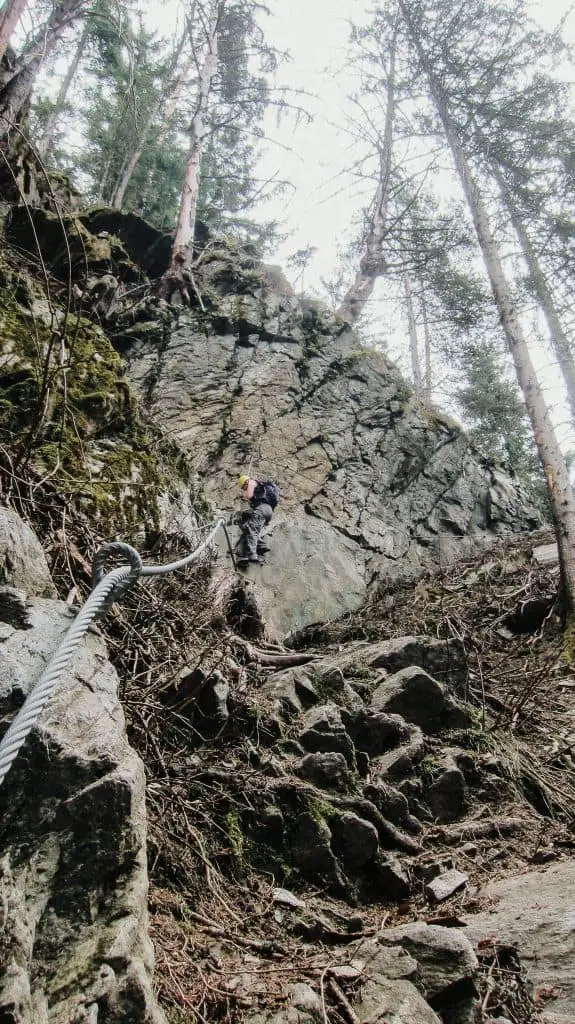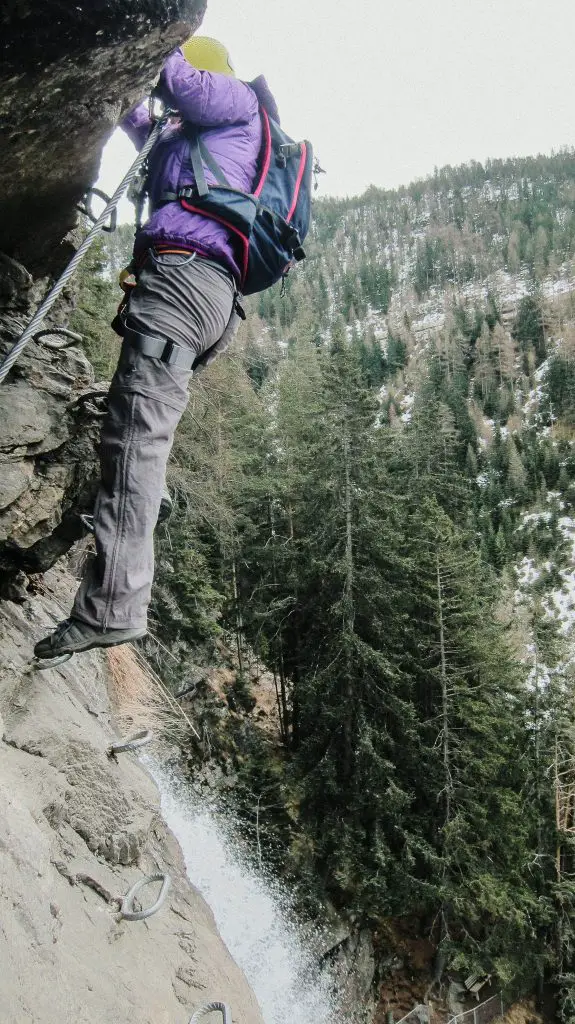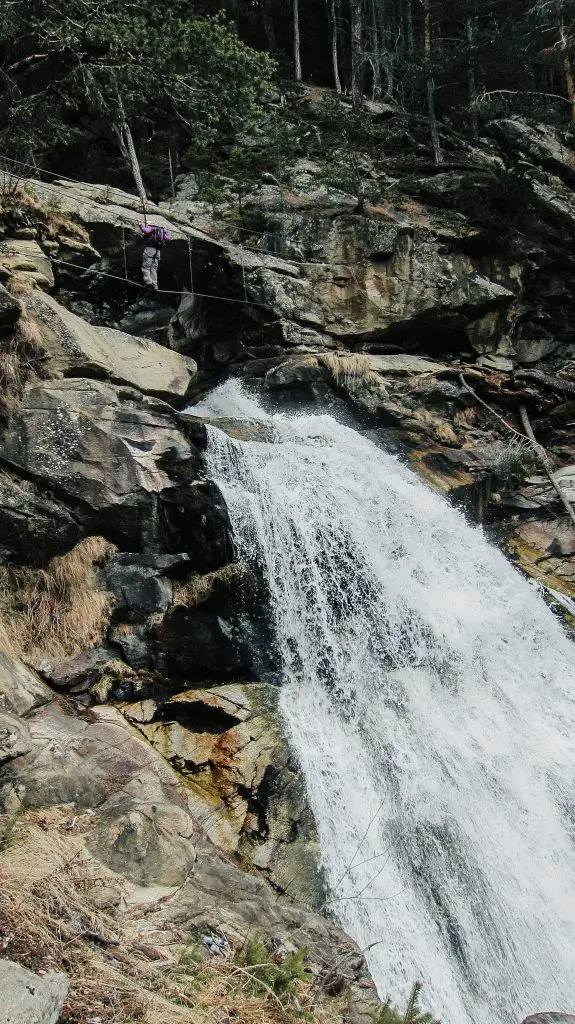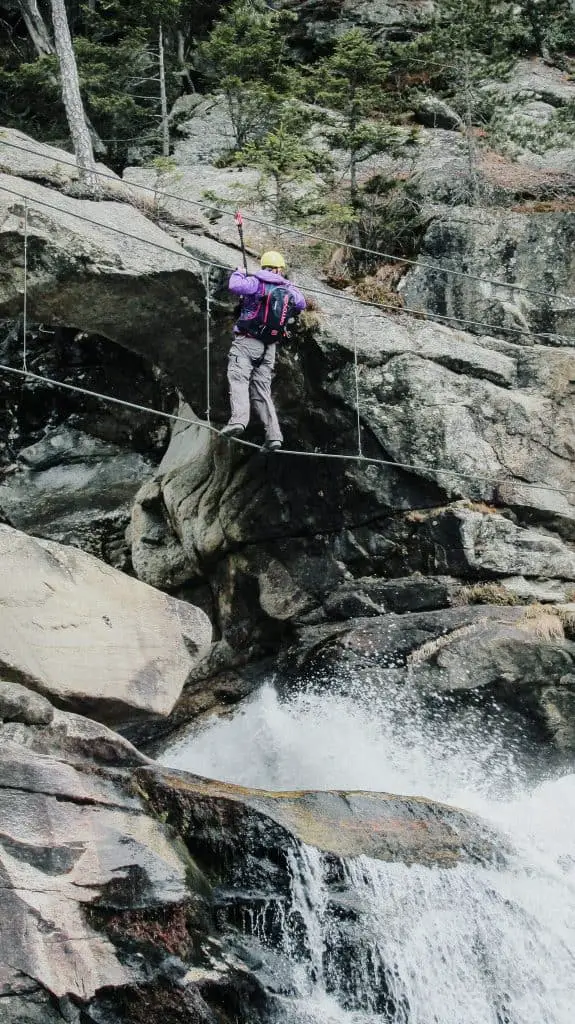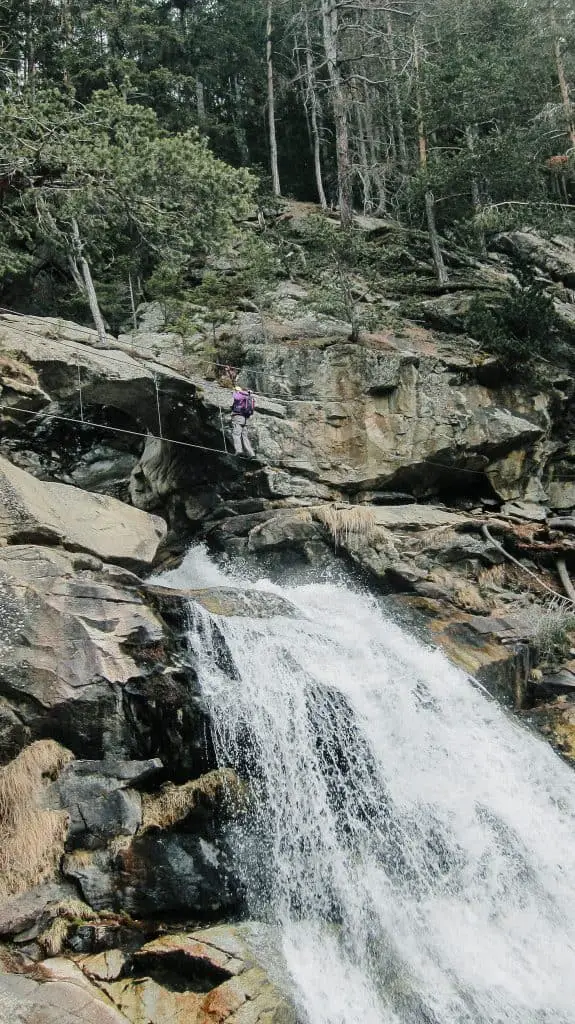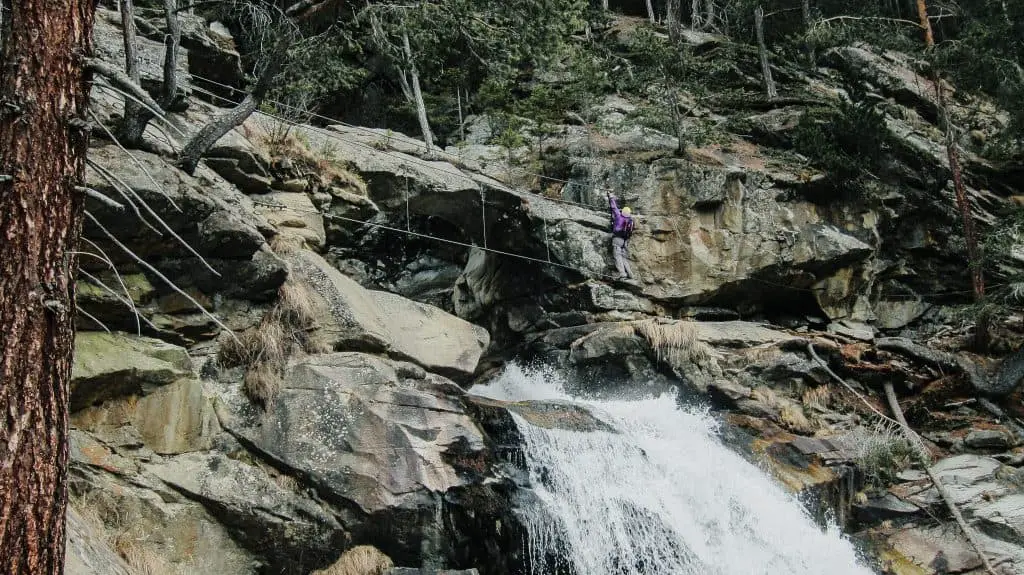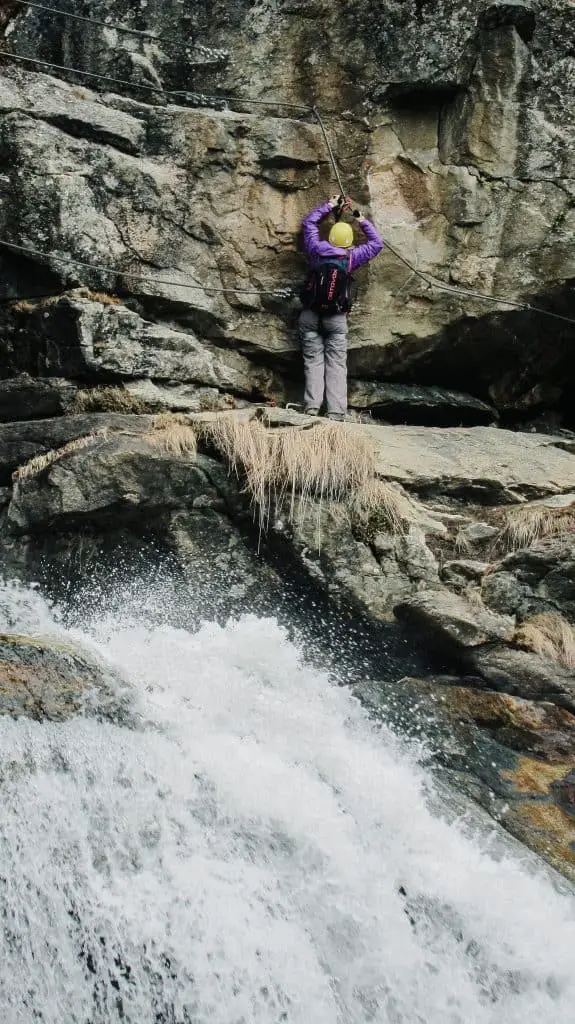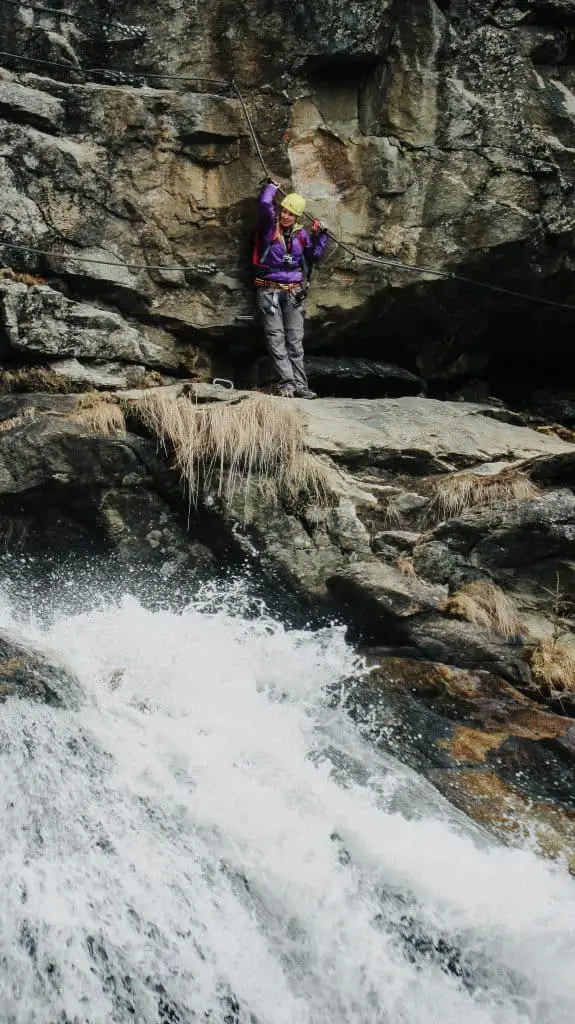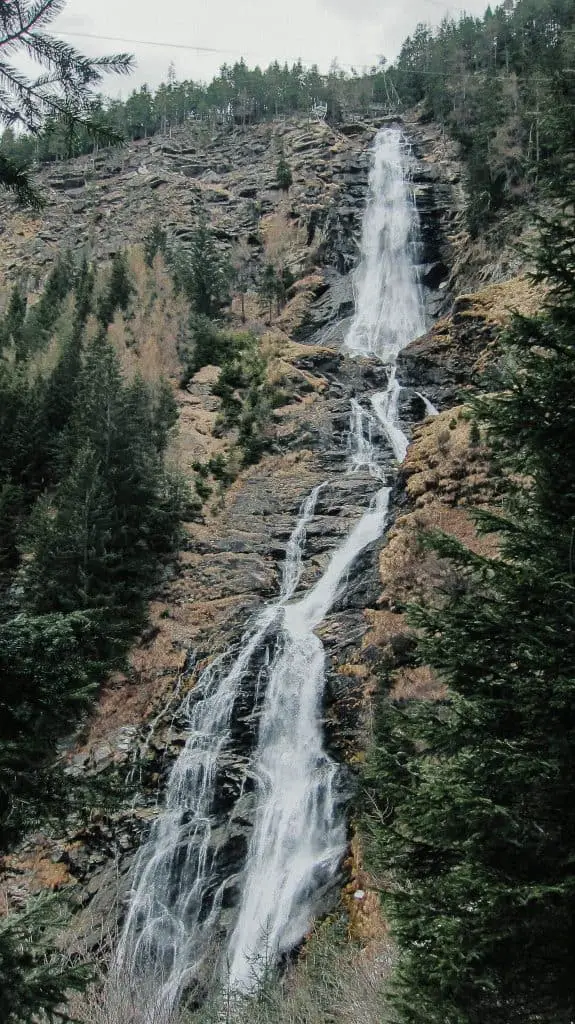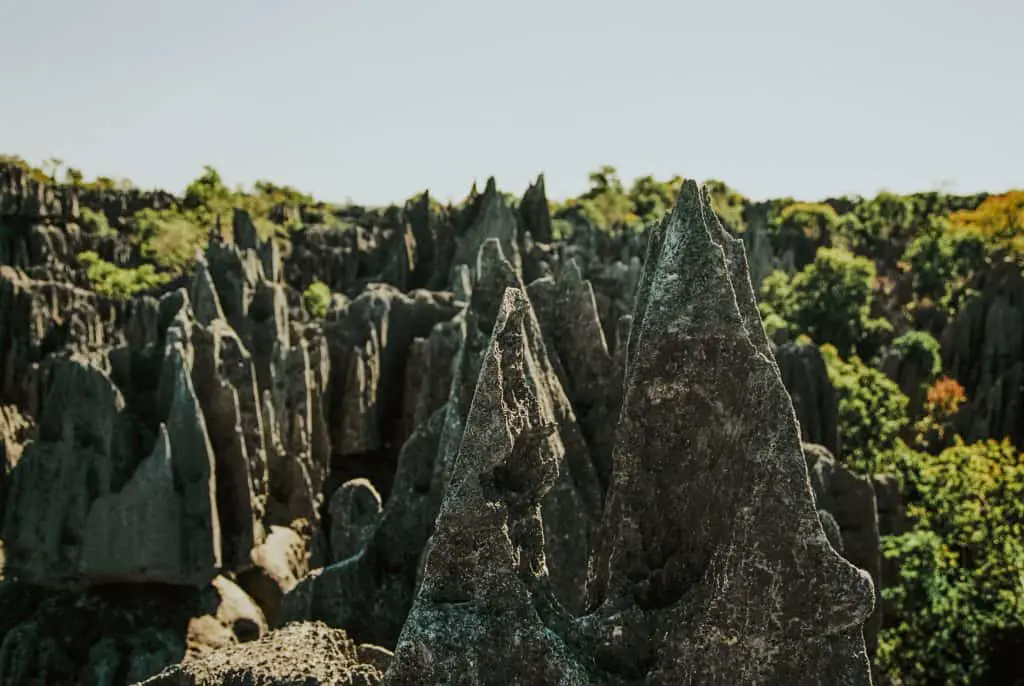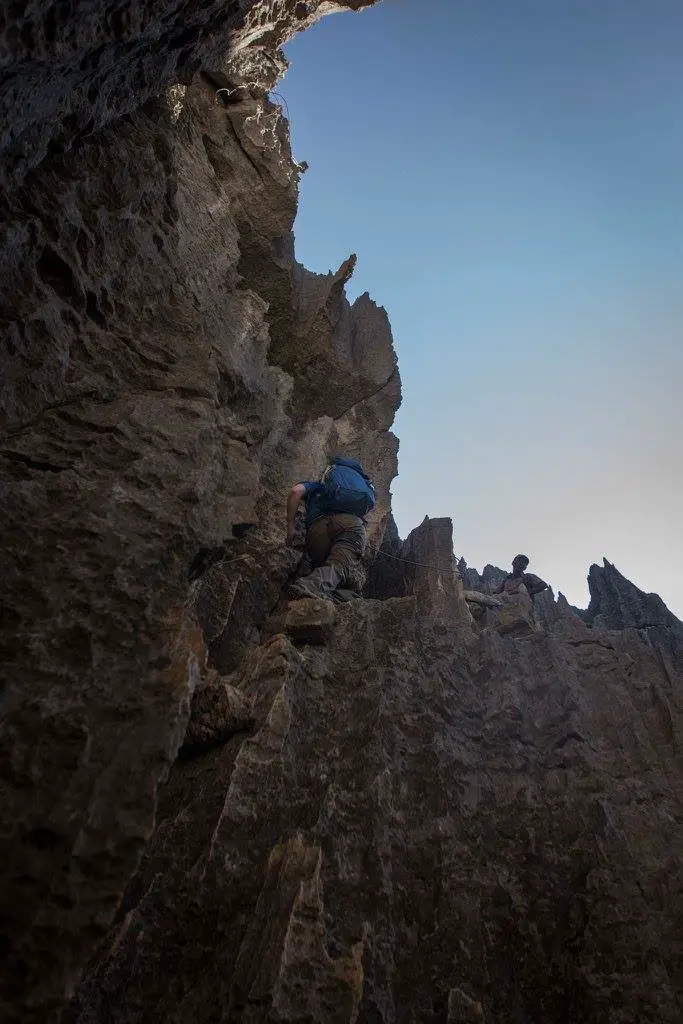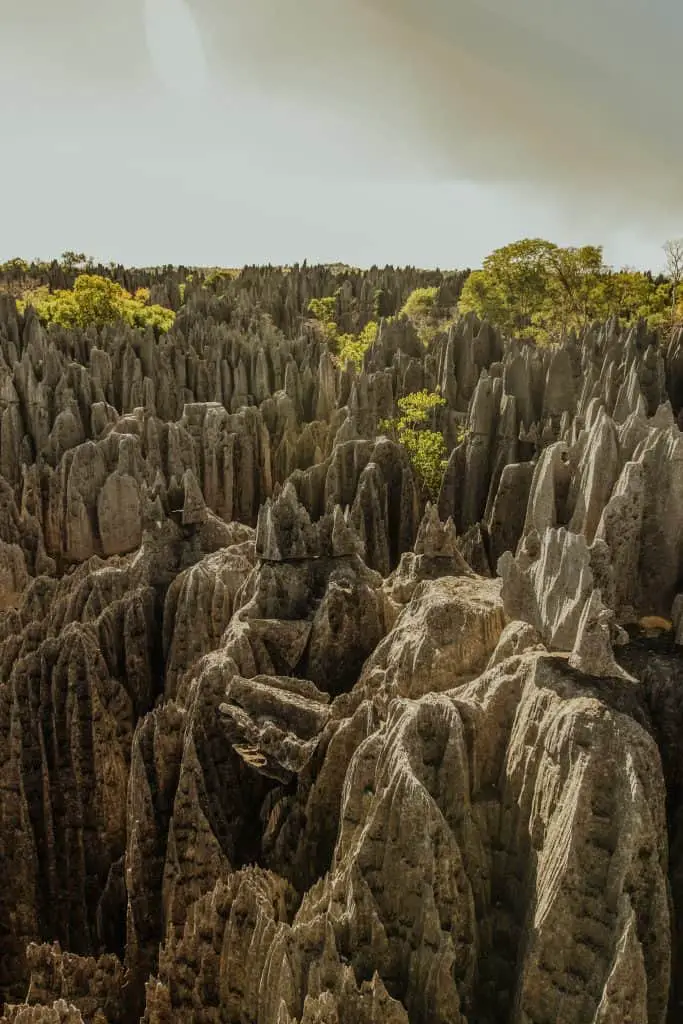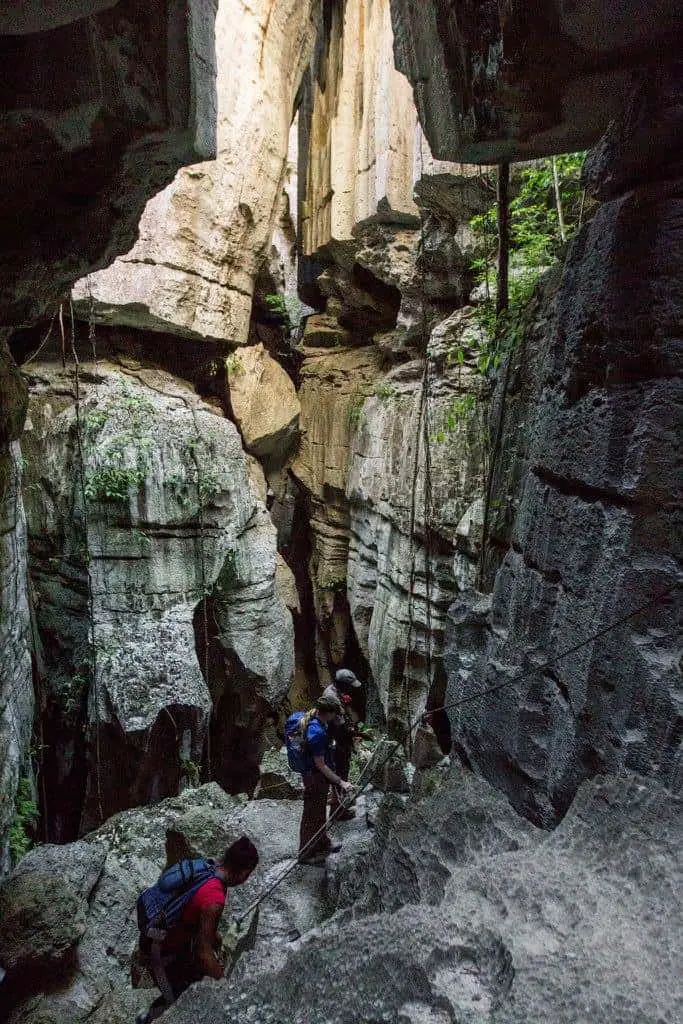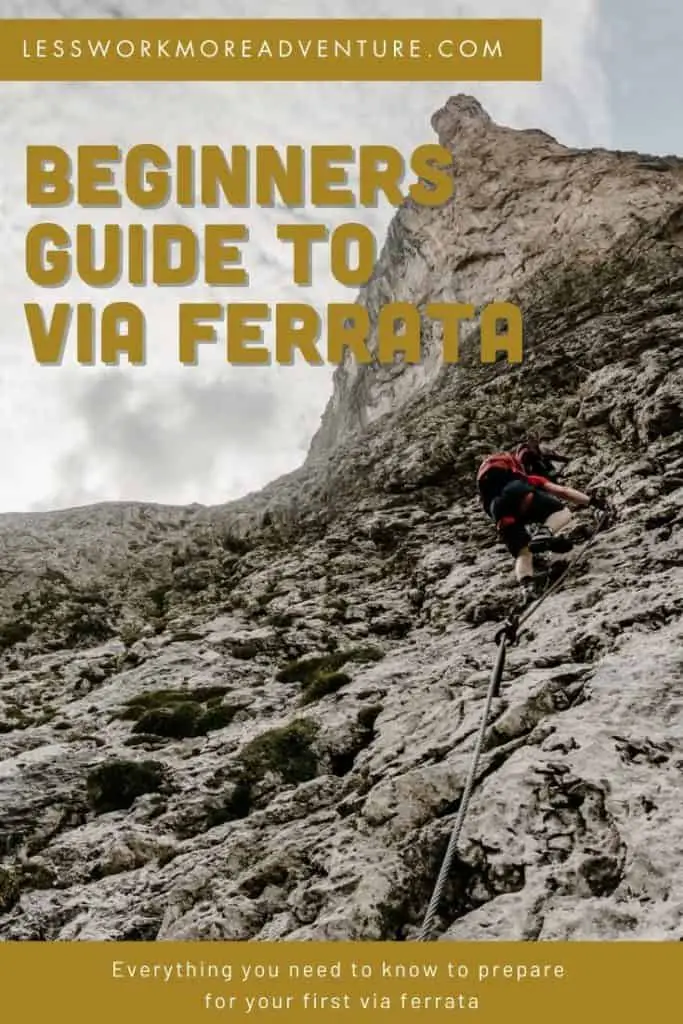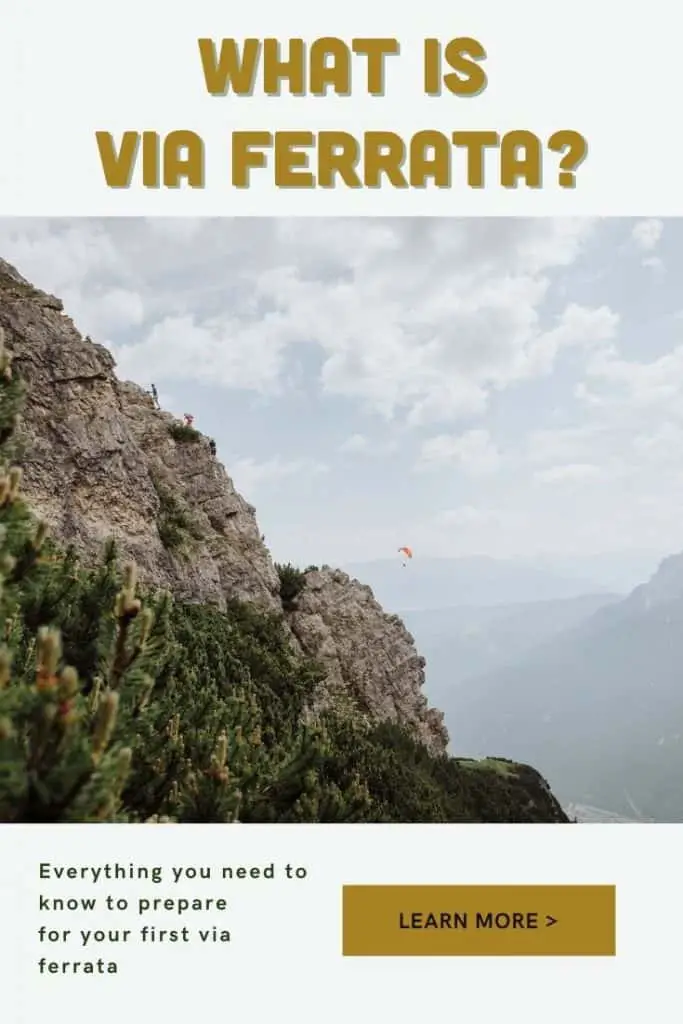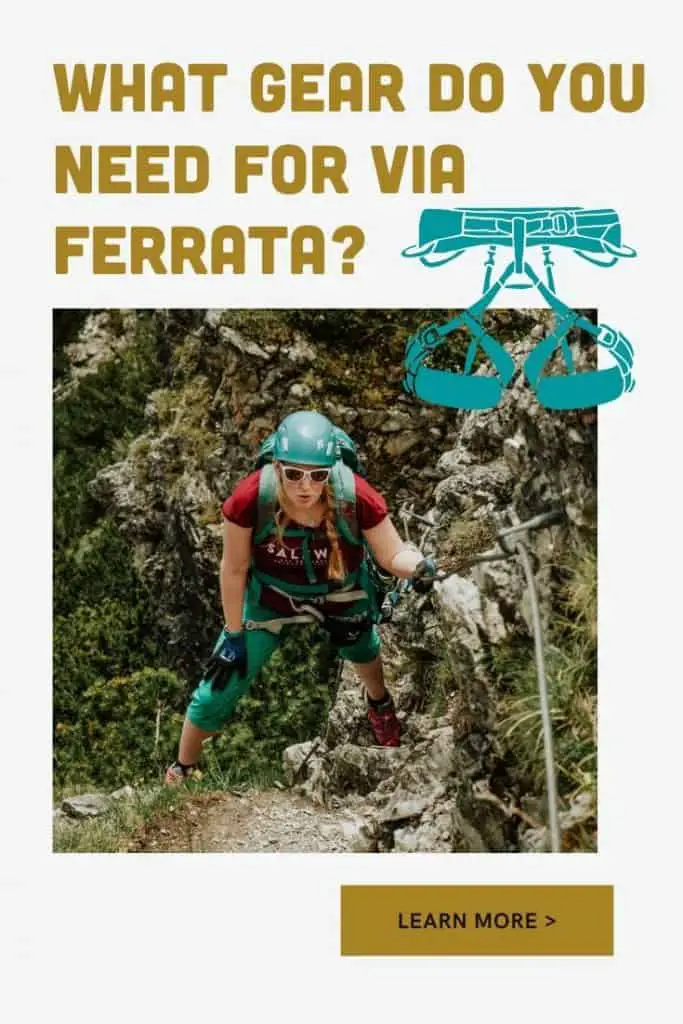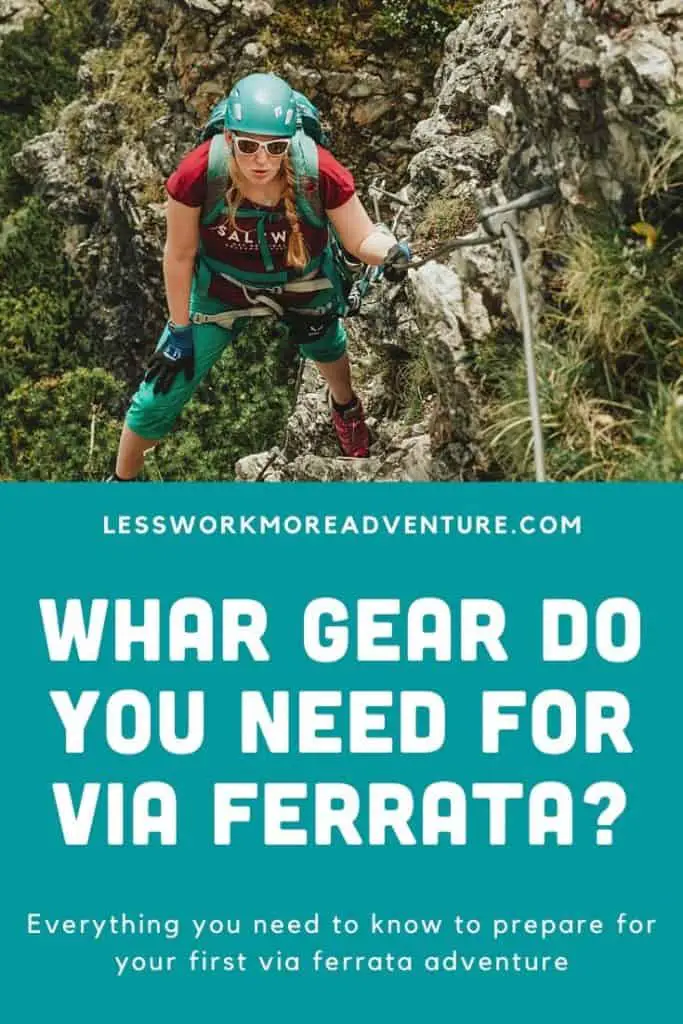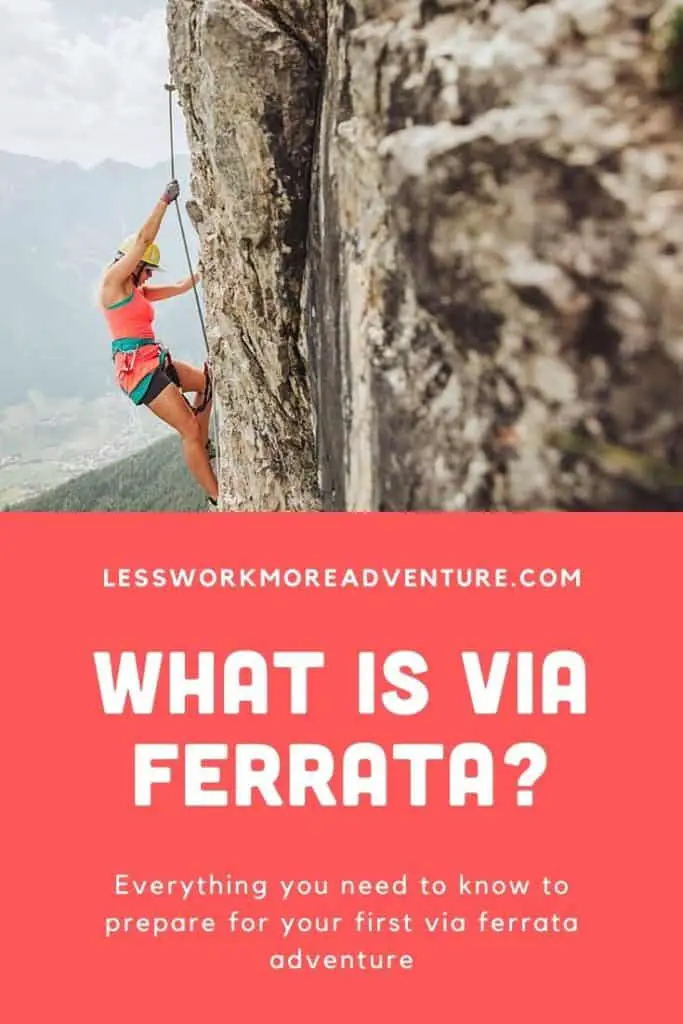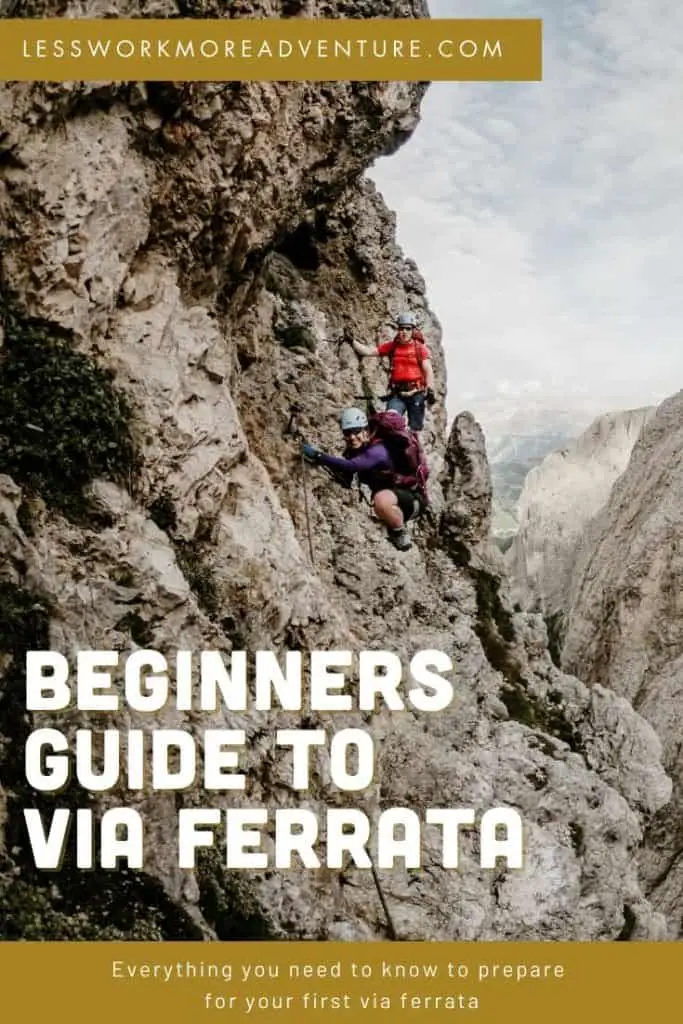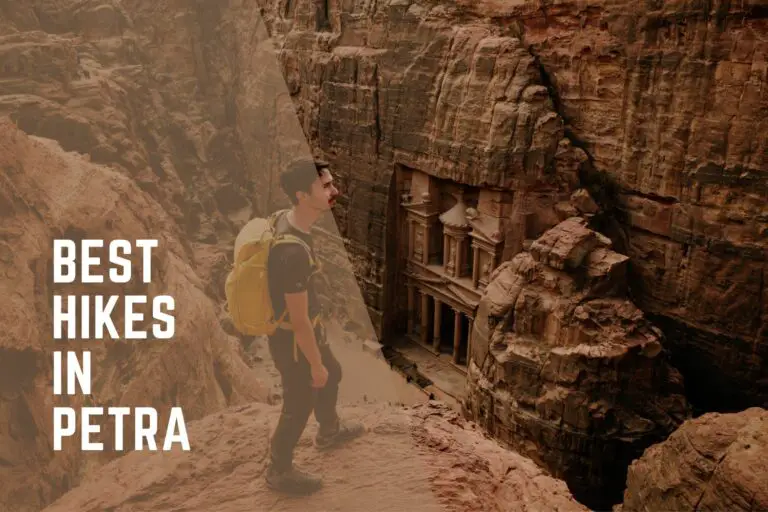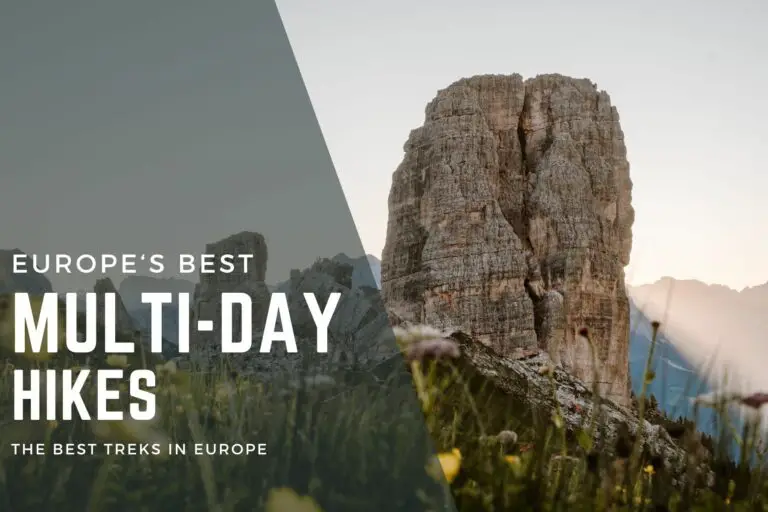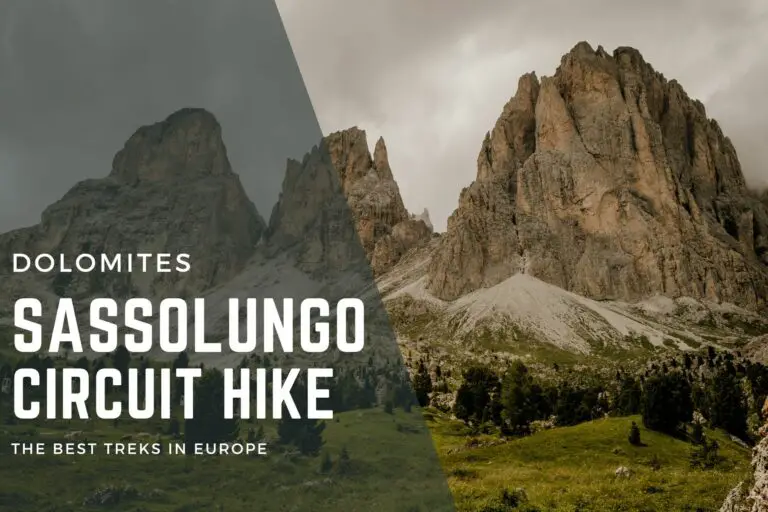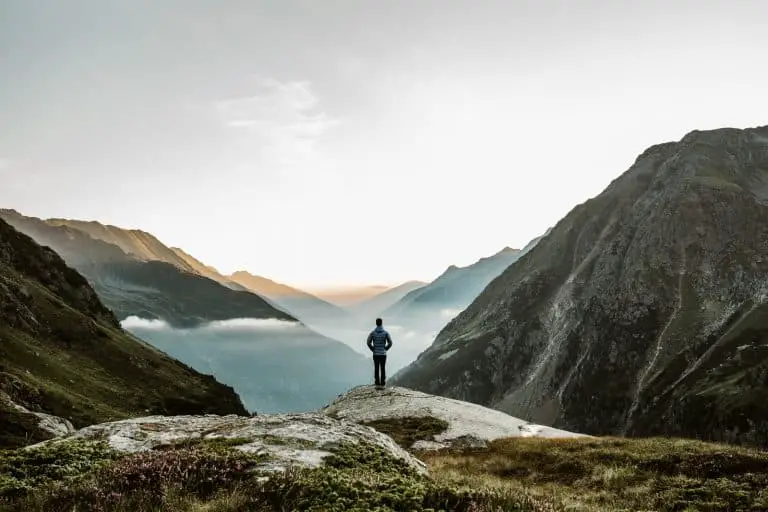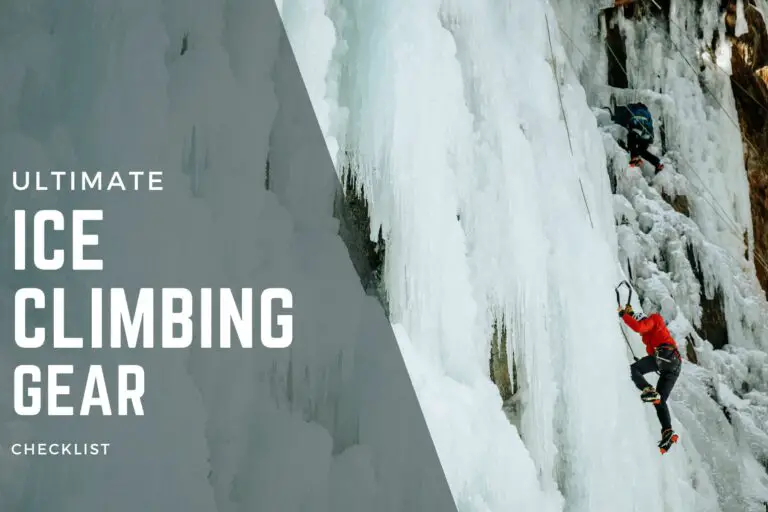Via Ferrata – A Beginners Guide
Disclosure: This post may contain affiliate links, meaning I earn a small commission if you decide to make a purchase though my links, at no additional cost to you, which I’ll probably spend on more outdoor gear and travel to cool places.
Table of Contents
Over the last couple of years I’ve discovered a love of climbing. But before I started sport climbing, Menno introduced me to via ferrata. We’re lucky to have a lot of via ferrata routes (or Klettersteig as it’s known in German speaking countries) pretty close to home across the Tirol and down in to the Dolomites, so I had easy access to training routes and the via ferrata gear. If you’ve heard about via ferrata before but aren’t sure what it is, or if it’s for you, then keep reading this complete beginners guide.
What is Via Ferrata?
Via ferrata originated in the Italian Alps as a way for troops to move through the mountains. Literally translating as ‘Iron Way’, steel cables were fixed into the mountain sides to secure exposed routes to allow people to cross in relative safety. These days they are popular around Europe, and even worldwide as a way to access some amazing terrain in ‘relative’ safety. While some via ferrata routes are require climbing technique, others are much more like hiking with the cables simply there for added safety when the terrain requires it.
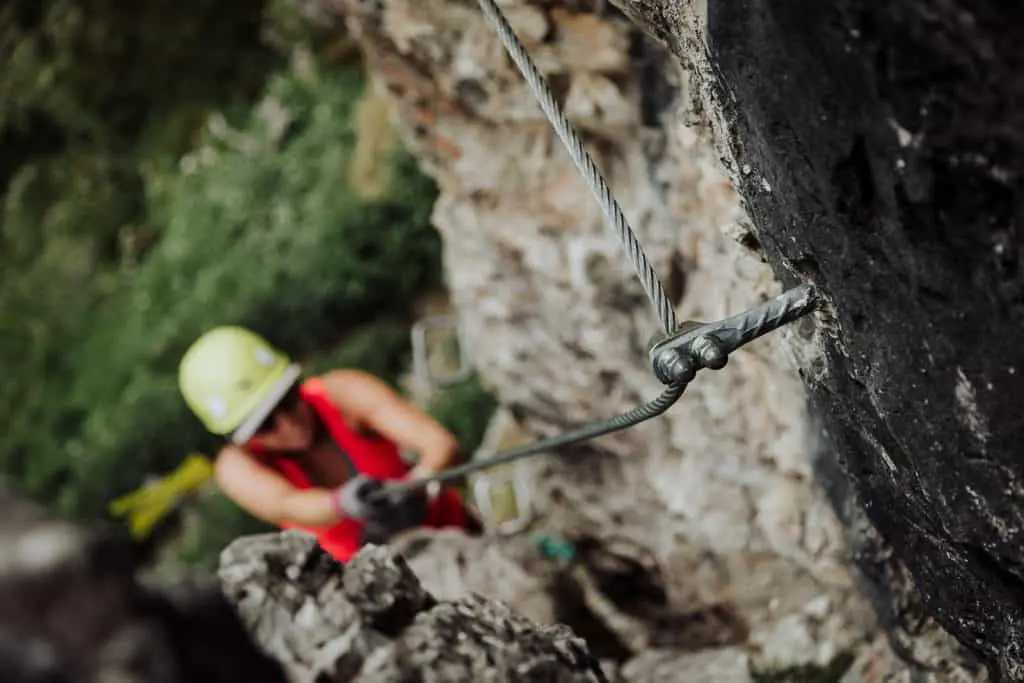
How do you climb a via ferrata?
Unlike traditional rock climbing with ropes, via ferrata climbing involves climbing a rock face or along a ridge which has a thick steel cable fixed along it. The cable has fixed anchor points along which climbers clip their safety equipment to in order to limit a fall. Via ferrata routes can also include ladders and cable bridges.
Do you need to be an experienced climber or mountaineer?
You don’t need experience in climbing or mountaineering to climb a via ferrata. But you do need to be sure-footed, have a reasonable level of fitness and a good head for heights.
Is via ferrata dangerous?
Via ferrata, like many mountain sports, isn’t without risk. You shouldn’t attempt a via ferrata if you don’t have the correct safety equipment or training in how to use it. Even with the right equipment and knowledge, there is always a possibility of a fall and injury in via ferrata. You are in high mountain terrain, and it’s never impossible to rule out factors such as falling rocks, inclement weather or human error.
Do you need a mountain guide?
You don’t have to have a mountain guide to do a via ferrata in most places in the Alps. However, if you’ve never done one before, and you’re not familiar with the equipment or used to being out in the mountains, then I would recommending hiring a guide for your first via ferrata tour. That way you’ll be sure that you won’t end up on a route that’s above your ability and you’ll be able to get down safely if something didn’t quite go as planned.

What Gear Do You Need For Via Ferrata?
For via ferrata you wear a standard climbing harness and helmet, but instead of using a rope, you have a special via ferrata kit for clipping safely on to the cables.
What is a Via Ferrata Set?
The via ferrata set consists of two elasticated lanyards with a special auto-locking carabiners on the end, attached to a central shock absorber. This via ferrata set is attached to the central belay loop of a climbing harness. In the event of a fall, as soon as the carabiner reaches the last fixed point of the cable, the shock absorber deploys which slows the descent of the climber.
When you reach an anchor point on a via ferrata, you unclip one carabiner and re-clip it to the next section of cable before the re-clipping the other one. This way you are always connected with at least one carabiner at all times. You should NEVER unclip both carabiners at the same time.
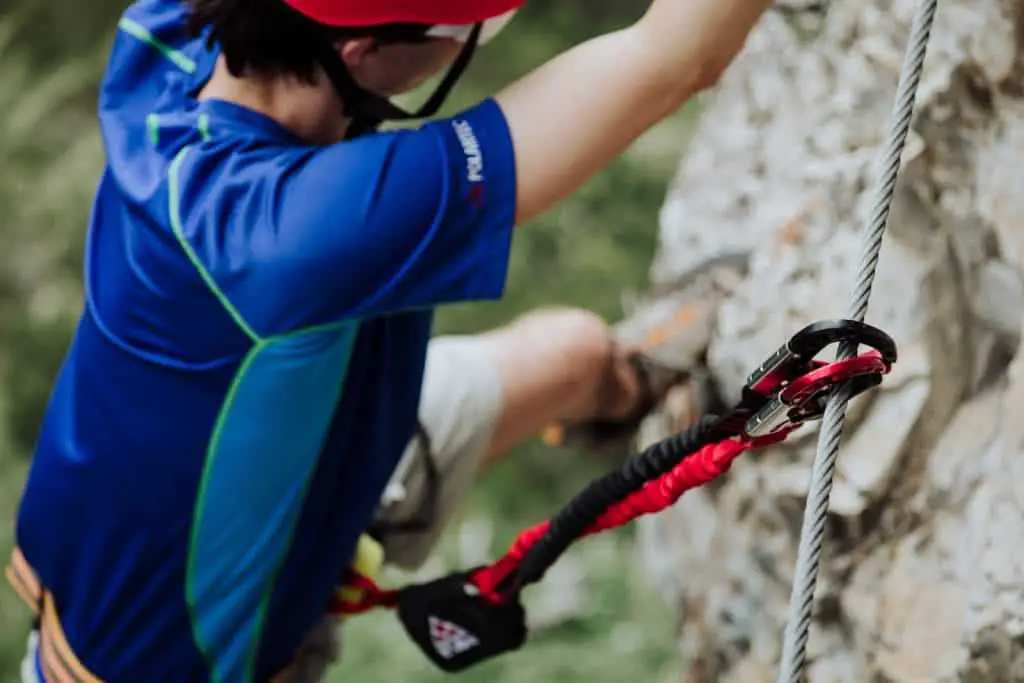
Can you use traditional climbing gear for via ferrata?
No. I’ve seen some really old via ferrata set ups made up of two piece of rope attached to crab claw carabiners which are not recommended. What’s definitely not recommended are what some really old-school climbers use which are a couple of slings. Why are these a bad idea? This type of gear can hold you when you’re just sitting in your harness, but it can’t take the shock-loading that happens in the event of a fall. If you are doing a via ferrata, no matter what your experience level is in climbing, you need to be using a proper via ferrata set which has a shock absorber to dampen a fall.
The harness and helmet for via ferrata are the same ones that you use for other types of climbing, so you don’t need a separate harness or helmet. It can also be beneficial if you have one to bring a Dyneema sling and locking carabiner for passages where you might want to hang at an anchor and take a rest. Just remember that you cannot use these for climbing – only resting.
While I don’t rock climb in gloves, I do climb via ferrata in gloves. Because I still like to feel my fingertips on the rock but don’t like the feeling of the steel cable in my hands, I like Black Diamond’s half-finger gloves which are specifically for via ferrata.
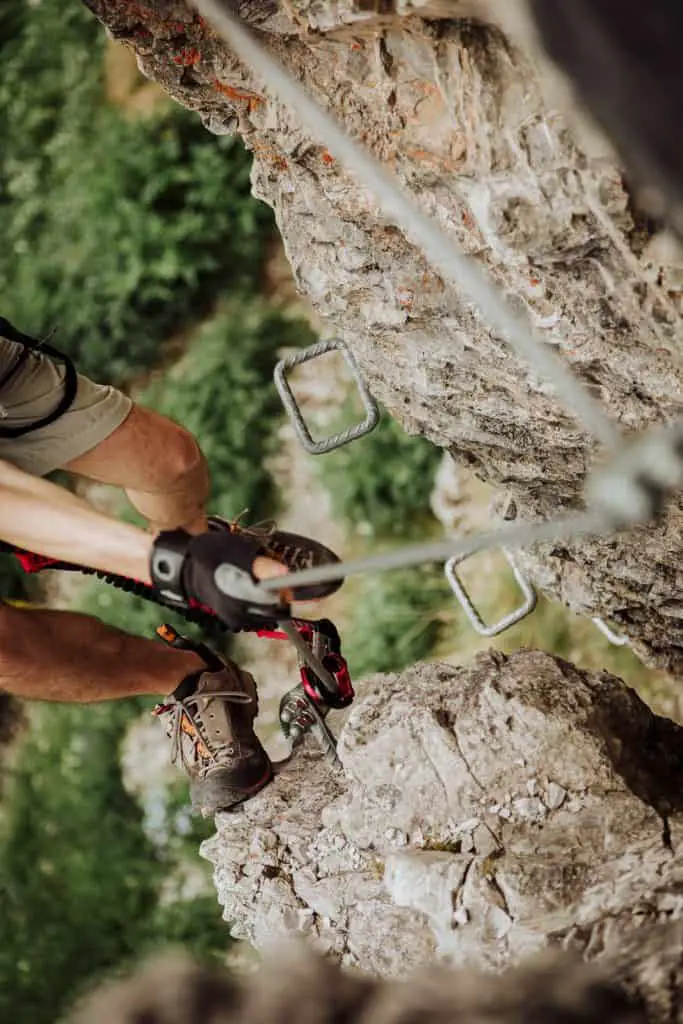
What is the best via ferrata kit?
Most of the companies who are making these via ferrata-specific safety sets are also the leading climbing hardware manufacturers.
Black Diamond, Salewa, Petzl, Camp, Edelrid and Stubai all make great via ferrata kit. Most have a few models available to suit different budgets. The cheaper options tend to have slightly different carabiners, usually with a twist-locking mechanism. The higher budget options, such as the Easy Rider from Black Diamond and the Ergotec from Salewa have a more ergonomic carabiner that is much easier to operate. And believe me, when you’re climbing for hours and clipping over and over again, paying a little more for a more ergonomic carabiner will make clipping so much easier and it’ll save you so much energy.
Menno and I both have different size hands, and we both chose different sets based on personal preference. But if you’re looking to buy one, here are some recommendations:

The Easy Rider from Black Diamond was one of the first on the market. It’s easy to use and light at 550g.
Buy online from:
Black Diamond (USA)
Epic TV Shop (Worldwide)
Bergzeit (EU)
Bergfreunde (EU)

This is my set. It’s slightly heavier than the Black Diamond at 605g, but I find the feel of the carabiners really nice and easy to use. I had my fall on these and bought the same one again after testing some others as I just really love the how easy these are to clip.
Buy online from:
Bergfreunde (EU)
Bergzeit (EU & Worldwide)

STUBAI Klettersteigset Basic Connect 2
This is Menno’s set, as he prefers the feel of this one to clip. It’s lighter than the Salewa at 550g and more budget friendly than many other models, since Stubai is a smaller company based in Tirol.
Buy online from:
Bergfreunde (EU)
Bergzeit (EU & Worldwide)
Where to buy via ferrata kit
If you are looking to buy your own via ferrata set, always buy it new and from an official retailer.
I don’t recommend buying second hand, as you can’t guarantee how old the gear is, if it has been properly cared for or if it has taken any falls. And since you are buying life-saving equipment, it’s worth spending the money to be certain it’s going to do its job. Any piece of climbing equipment that has any material elements (rope, harness, lanyards, slings) must be retired from use after 10 years regardless of how often they have been used. As soon as a via ferrata set has been fallen on and the shock absorber has been torn, it is no longer safe to use and must be replaced.
Whilst researching this article, I found that many US outdoor retailers didn’t stock VF kit, or if they did, only stocked one model, usually with the cheaper twist-locking carabiners which I don’t recommend as they are much more tiring to use. However, it does seem that a couple of the bigger European shops will ship worldwide, so if you are looking to buy your own gear and you don’t live in Europe, check out these online stores:
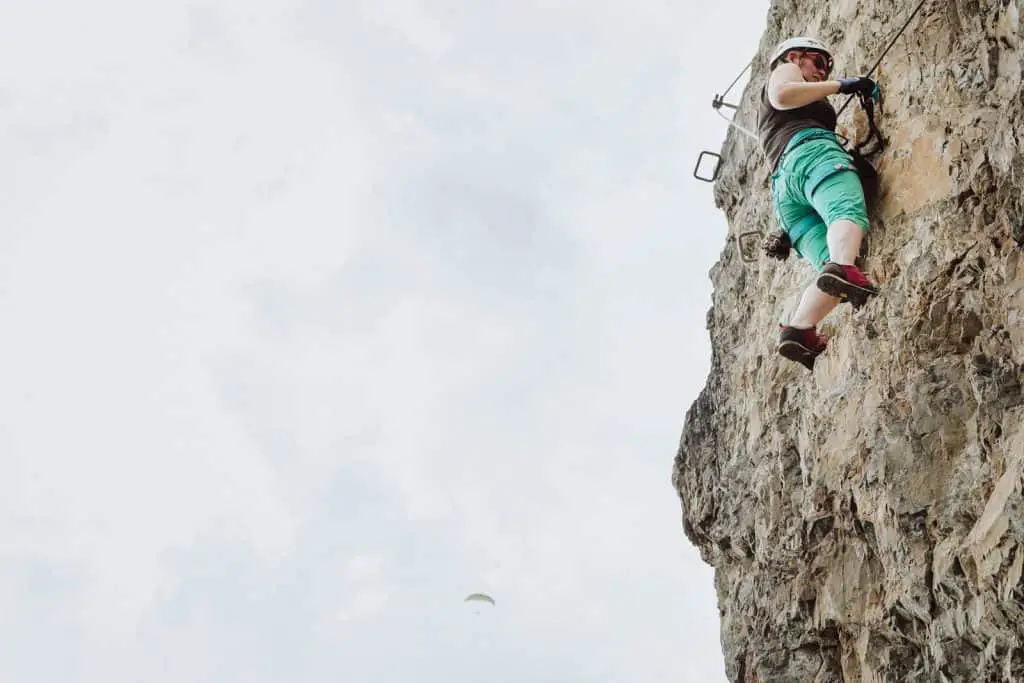
What Shoes Should You wear for Via Ferrata?
Choosing the right shoe for via ferrata depends on factors such as the approach and descent terrain, and the length and technicality of the route.
A via ferrata shoe needs to have a fairly stiff sole to support your foot, as you’ll be spending lots of time standing on small rock edges, ladders and a steel cables. It also needs to be extremely durable, so ones with a rubber rand around the edge are ideal.
If the approach is only short and on a relatively easy trail, you might be happy wearing a stiffer approach shoe. But when you’ve got longer approaches or descents, or the climb is part of a longer hike, then I’d recommend wearing a boot with ankle support instead. I wear ones from Salewa as I find them super comfortable for both hiking all day and on via ferrata.
What to pack for a via Ferrata
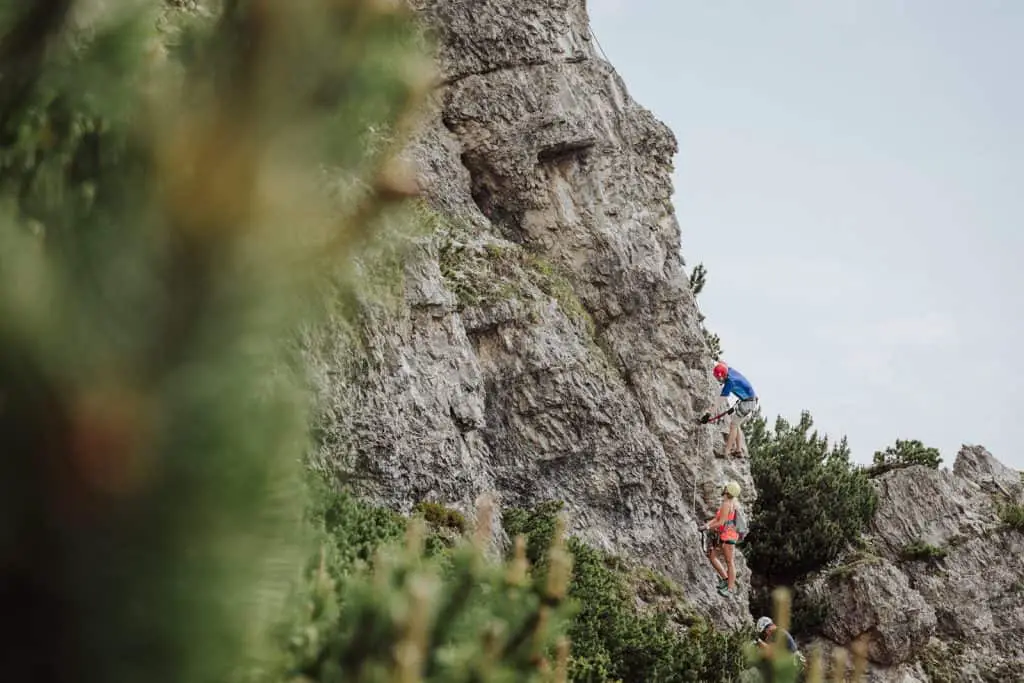
Is it safe to fall on a via ferrata?
In sport and trad climbing taking a fall is part of the sport. Whilst you might have a fear of falling, generally as you progress, you learn that falling is, in most cases, completely safe. In via ferrata, however, while you have the gear to protect you in the event of a fall, you want to avoid falling. Your gear is there as life-saving equipment to protect you in a worst-case scenario. It’s not designed to take repeated falls. You should choose routes below your limit where there is little to no chance you could take a fall.
When you fall on a via ferrata, you’ll fall back down the section of cable to the last fixed anchor where you clipped. From that point the elastic on your set will help to soften your fall, and depending on the distance and speed, the shock absorber inside your via ferrata set may also then come into play. This all depends, however, on what is beneath you. Having fallen on a via ferrata once myself, I actually hit a ledge and the rock before my shock absorber slowed my fall, but it was enough to start to load the shock absorber, meaning the whole set would need to be replaced as it wouldn’t now protect me if I fell again.
Here’s a video from Edelrid explaining how the shock absorber works when you take a fall on a via ferrata:
How are via ferrata routes grated?
Via ferrata routes are graded differently to other types of climbing. In much of Europe, routes are graded from A to E for difficulty. Grade A is generally more like an easy bolted scramble with lots of grips to hold and places to stand. While E is only for experienced climbers, as it’s likely to be vertical or overhanging, with lots of exposure and fewer foot and hand holds.
When looking at the grading of a route, it’s important to not just look at the overall grading, but also the full topo to see what the individual sections are. It’s important to know if the route has any ‘escape points’ and where they are, and to asses the potential challenges of the route. You can usually find a copy of the topo in the guidebook or on websites such as Bergsteigen.com.
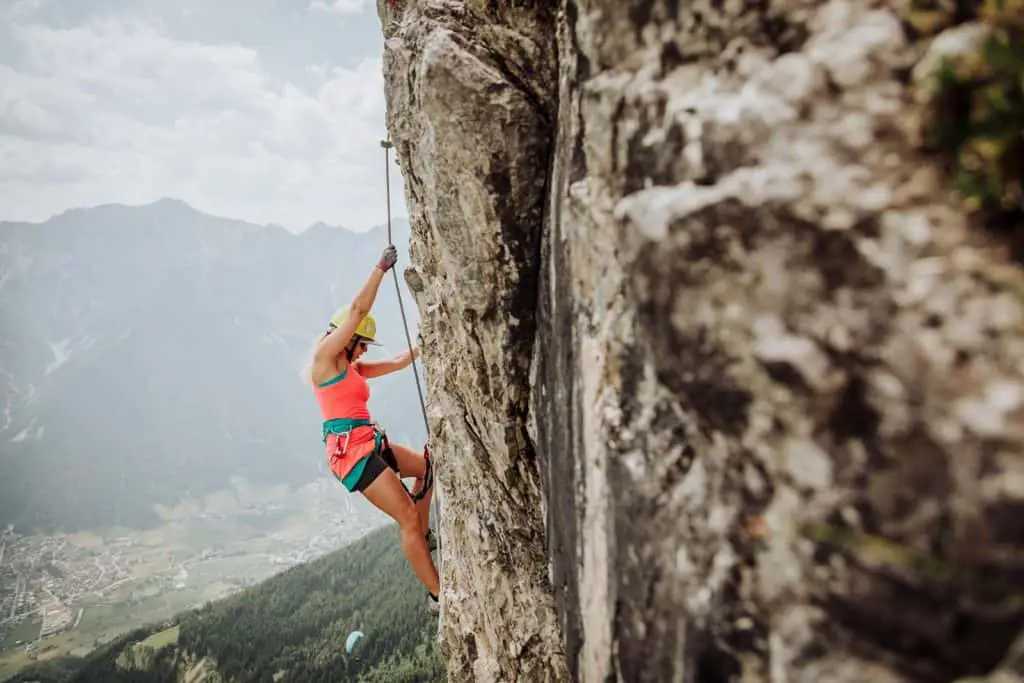
Where Can You Climb Via Ferrata?
If you want to be spoiled for choice on routes, head to Europe. While via ferrata started in the Dolomites, these days you’ll find them all across the Alps.
Via Ferrata In The Dolomites
The Dolomites are the home of via ferrata and with over 400 routes to choose from, you’ll find some epic ones for all abilities. Some of the classic routes include the Brigata Tridentina (pictured below), Monte Paterno at the Tre Cime di Lavaredo or Averau for novice climbers.
Find tours in the Dolomites with a mountain guide
Routes In Austria
Via ferrata is extremely popular in the Austrian Alps, although here it’s known by the name ‘Klettersteig’. In fact, there are around 950 routes to choose from, ranging from short training routes called ‘übungsklettersteig’ to long ridge traverses over multiple summits and routes that scale some of the largest waterfalls.
For beginners, the training klettersteig at Schlick 2000 in the Stubai Valley is ideal, as is the family klettersteig in Mayrhofen in Zillertal. Or for something a bit longer and more challenging, check out the Stuibenfall waterfall klettersteig in the Ötztal valley or the Innsbruck Klettersteig ridge traverse.
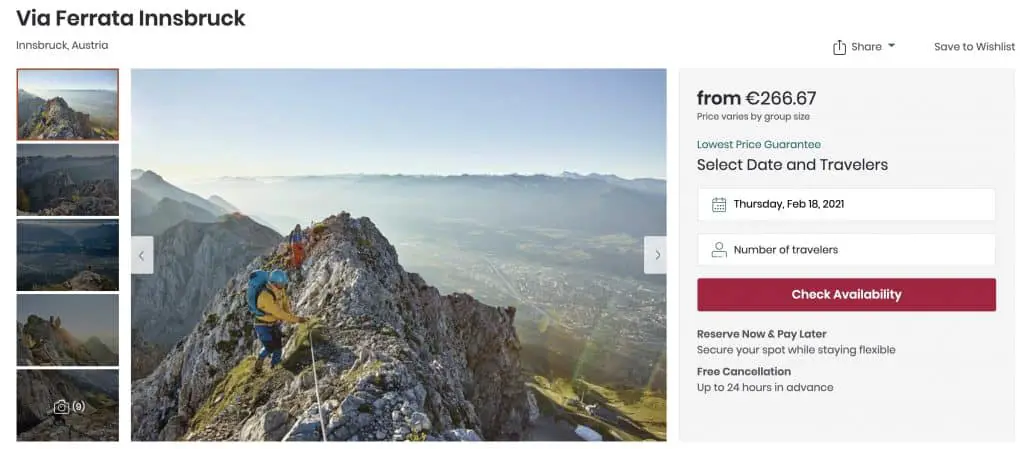
Routes in Switzerland
Perhaps the most famous via ferrata in Switzerland is the Mürren klettersteig that hugs the wall on the side of the valley above Lauterbrunnen, just outside Interlaken in the Bernese Highlands. This athletic route is known for it’s long suspension bridges and Tirolean traverse that cross huge ravines.
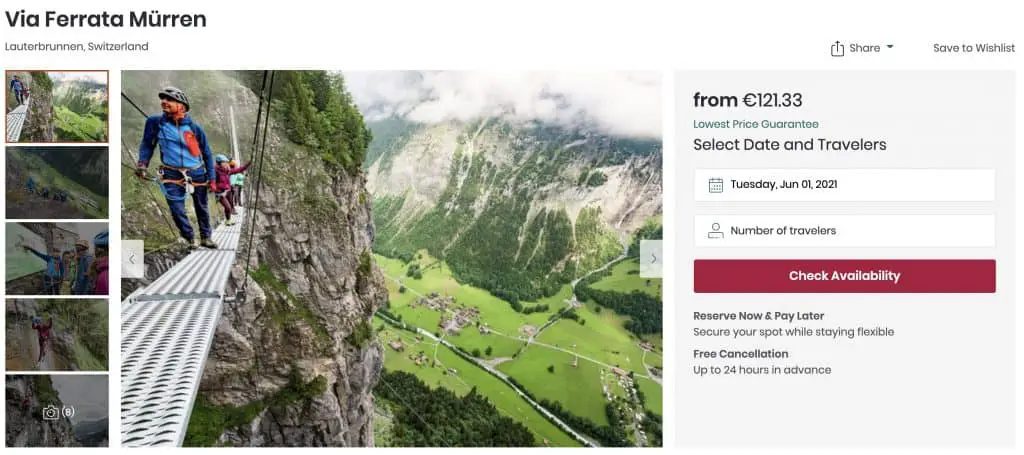
Via Ferrata in the rest of Europe
Other countries where you’ll find via ferrata in Europe include:
– Montenegro
– Slovenia
– UK
– Croatia
– Kosovo
– Greece
– Norway
– Spain
Via Ferrata in the rest of the world
While via ferrata is definitely a big thing on the adventure recreation scene in Europe, it’s cropping up in other places too. You can find them in China, Indonesia, Mexico, Peru. We even found one in Madagascar during our honeymoon in 2015.
Shop Via Ferrata Gear
Already love it? Here’s some inspiration for your next adventure: World’s 10 Best Via Ferrata Routes

